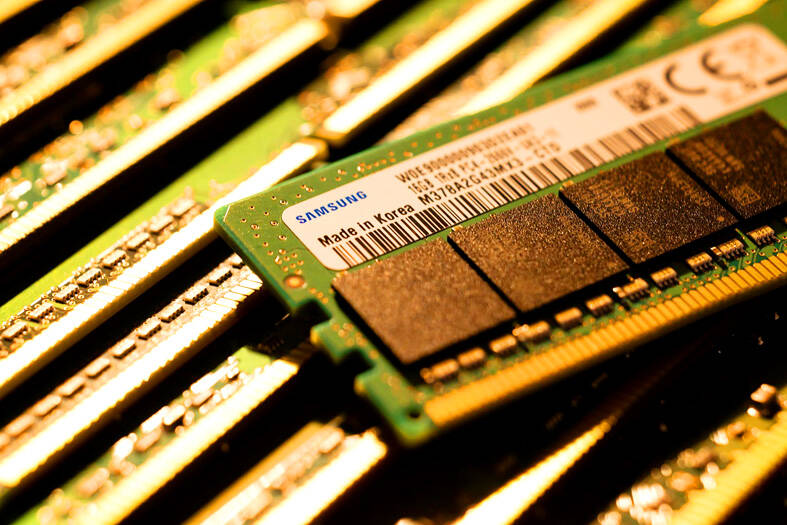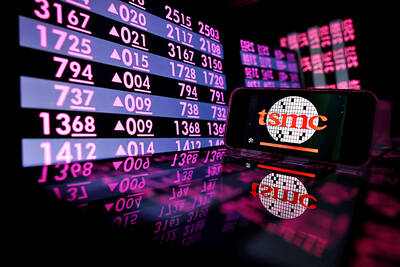The contract prices of DRAM chips are to rise by as much as 18 percent sequentially this quarter — the first price upticks in about eight quarters — driven mainly by inventory rebuilding demand for DRAM chips used in mobile devices and PCs, TrendForce Corp (集邦科技) projected yesterday.
The price rebound is led by a quarterly increase of mobile DRAM chips, which are to climb between 13 percent and 18 percent quarter-on-quarter this quarter, which has not been seen since the fourth quarter of 2021, the Taipei-based market researcher predicted.
Likewise, the price of mainstream PC DDR4 DRAM is expected to bounce back for the first time in about two years at a quarterly pace of 9.6 percent this quarter, the researcher said, adding that the prices have plummeted 64 percent since the final quarter of 2021.

Photo: Bloomberg / Seong-Joon Cho
As the pickup remains lukewarm, TrendForce expects DRAM chipmakers to see scant growth in shipments this quarter. Additionally, the researcher has a conservative outlook for server DRAM chips, given that inventory continues to hover at a high level.
As a result, Samsung Electronics Co — the world’s largest memorychip maker — is to accelerate its capacity reduction this quarter by slashing mainstream DDR4 chip production by 30 percent to alleviate inventory pressure, TrendForce said.
Last quarter, the world’s major DRAM chipmakers saw their revenue increase 18 percent sequentially to total US$13.48 billion, benefiting from a gradual improvement in demand during the second half of this year, TrendForce said in a report yesterday.
Samsung registered 15.9 percent quarterly growth in revenue to US$5.25 billion, as the South Korean memorychip maker started cranking out its first new-generation 1-alpha-nanometer DDR5 chips, which delivered a price premium, the report said.
SK Hynix Inc, the world’s second-largest memorychip maker, enjoyed the strongest revenue growth of 34.4 percent sequentially to US$4.63 billion, supported by robust demand for high-bandwidth memory and DDR5 chips, which were mostly used in artificial-intelligence servers, the report said. SK Hynix has seen shipments rise for a third consecutive quarter beginning last quarter, with memorychip prices jumping 10 percent quarterly, it said.
US memorychip maker Micron Technology Inc reported a 4.2-percent growth in revenue to US$3.08 billion last quarter, attributable to shipment expansion, while it saw a mild decline in average selling price last quarter from the previous quarter.
Taiwan’s Nanya Technology Corp (南亞科技) saw revenue grow 10 percent quarterly last quarter to about US$244 million, thanks to shipment increases at a quarterly rate between 17 and 19 percent due to improving PC DRAM demand. However, demand for its major DDR3 and DDR4 products remained sluggish last quarter, as prices for these chips extended in a downward trend from the previous quarters.
Winbond Electronics Corp (華邦電) and Powerchip Semiconductor Manufacturing Corp (力積電) saw their DRAM revenue sequentially rise 13 percent and 4.4 percent respectively last quarter, TrendForce said.

Taiwan Semiconductor Manufacturing Co (TSMC, 台積電) yesterday said that its investment plan in Arizona is going according to schedule, following a local media report claiming that the company is planning to break ground on its third wafer fab in the US in June. In a statement, TSMC said it does not comment on market speculation, but that its investments in Arizona are proceeding well. TSMC is investing more than US$65 billion in Arizona to build three advanced wafer fabs. The first one has started production using the 4-nanometer (nm) process, while the second one would start mass production using the

A TAIWAN DEAL: TSMC is in early talks to fully operate Intel’s US semiconductor factories in a deal first raised by Trump officials, but Intel’s interest is uncertain Broadcom Inc has had informal talks with its advisers about making a bid for Intel Corp’s chip-design and marketing business, the Wall Street Journal reported, citing people familiar with the matter. Nothing has been submitted to Intel and Broadcom could decide not to pursue a deal, according to the Journal. Bloomberg News earlier reported that Taiwan Semiconductor Manufacturing Co (TSMC, 台積電) is in early talks for a controlling stake in Intel’s factories at the request of officials at US President Donald Trump’s administration, as the president looks to boost US manufacturing and maintain the country’s leadership in critical technologies. Trump officials raised the

‘SILVER LINING’: Although the news caused TSMC to fall on the local market, an analyst said that as tariffs are not set to go into effect until April, there is still time for negotiations US President Donald Trump on Tuesday said that he would likely impose tariffs on semiconductor, automobile and pharmaceutical imports of about 25 percent, with an announcement coming as soon as April 2 in a move that would represent a dramatic widening of the US leader’s trade war. “I probably will tell you that on April 2, but it’ll be in the neighborhood of 25 percent,” Trump told reporters at his Mar-a-Lago club when asked about his plan for auto tariffs. Asked about similar levies on pharmaceutical drugs and semiconductors, the president said that “it’ll be 25 percent and higher, and it’ll

CHIP BOOM: Revenue for the semiconductor industry is set to reach US$1 trillion by 2032, opening up opportunities for the chip pacakging and testing company, it said ASE Technology Holding Co (日月光投控), the world’s largest provider of outsourced semiconductor assembly and test (OSAT) services, yesterday launched a new advanced manufacturing facility in Penang, Malaysia, aiming to meet growing demand for emerging technologies such as generative artificial intelligence (AI) applications. The US$300 million facility is a critical step in expanding ASE’s global footprint, offering an alternative for customers from the US, Europe, Japan, South Korea and China to assemble and test chips outside of Taiwan amid efforts to diversify supply chains. The plant, the company’s fifth in Malaysia, is part of a strategic expansion plan that would more than triple